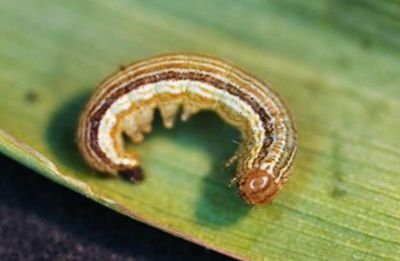 (Image: GROWMARK, Inc.)
(Image: GROWMARK, Inc.)
- Reports of fall army worm infestations are increasing in parts of the country
- Fall armyworms can cause substantial damage to several crops under the correct conditions
- Issues with pyrethroid performance on this pest have been reported
Recent reports of fall armyworm (FAW) have increased in parts on Kentucky, and those in surrounding areas and northwards should start to pick up scouting efforts. While the mid-Atlantic has yet to see a repeat of last year's infestation, it is important to be on the lookout for signs and be aware of mitigation options.
FAW is an erratic pest of relative concern to several crops. Most often we observe issues in forage grasses, alfalfa, and soybeans, especially those in double crop systems. FAW also feed on corn and can be problematic in late-planted fields and fields with hybrids lacking a labeled Bt trait for this pest. Damage typically is worse during droughty conditions. Large larvae are voracious feeders and approximately 80% of their feeding and damage within the last 3 days of their time as larvae, making early detection essential.
General Overview
FAW do not overwinter in the northern part of the U.S. Adult moths migrate into the region from Southern areas each year, typically around mid-July, where they mate and deposit eggs in grassy areas. Once initial food sources are depleted, they “march” en masse into lush areas, which typically includes soybean fields, late planted corn, and forage grass / alfalfa fields, and potentially small grains and cover crops. Once their development is complete, they move to the soil and pupate. Usually only one generation per growing season is observed in this region. Heavy FAW infestations in fields one year does not indicate an issue will occur next season as the insect cannot survive our winter conditions.
FAW like to feed on lush, green tissues. Damage includes mild to severe foliar feeding in most crops, and in soybeans pod feeding can occur. Stems also can be cut (Figure 2). In some cases, plants can have leaf tissue completely removed. Feeding on corn ears similar to that of corn ear worm may be present on late-planted corn fields.
With alfalfa, feeding by FAW certainly can affect yields if another cutting is scheduled and the larvae will reach critical size before cutting. If infestations persist due to warm temperatures, feeding FAW may have a similar impact on alfalfa overwintering as one would have with a late cutting. The pruning of foliage may reduce storage of carbohydrates in the roots and crown that are needed to regrow in the Spring. In this case, treatment decisions are a little more difficult. Use an economic threshold of 3 larvae per square foot a guide.
The following guidelines should be considered when making a treatment decision for FAW in various crops:
Soybeans
Averaging more than 10 FAW larvae in 25 sweeps across a field in small soybeans or 20% defoliation pre bloom.
- Post bloom- >15% defoliation
Alfalfa
- Treat if a cutting is scheduled, FAW are present at threshold numbers, and larvae are less than ¾ inches long.
- If larvae are larger than ¾ inch and cutting is scheduled, cutting early is recommended. FAW larger than ¾ inch are nearly impossible to kill.
- Treatment is not recommended if cutting is not scheduled, and you are entering a period of cool weather. However, if thresholds have been reached, an application may be warranted if temperatures are forecast to remain warm over the subsequent 3-4 weeks.
Cereal Rye &Small Grains
- Do not treat unless FAW is present in fields before tillering has started. Risk is reduced in grain crops planted after the Hessian fly free date.
- Neonicitinoid seed treatments have some suppressive effects in other systems, but the jury is out in small grain systems.
If making an application, follow the recommendations below:
- Only treat fields with larvae less than ¾ long.
- Fields with 3 or more larvae per square foot are likely to see an economic benefit of an insecticide treatment
- Try to apply a product with two modes of action if economics warrant it
- Make applications early in the day or at sundown. FAW will feed during the day, but more individuals will be active early and late in the day, making insecticide applications more effective.
References